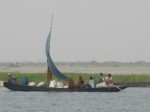 Most of us agree that deforestation on the scale we have seen in recent decades is undesirable and unsustainable.
Most of us agree that deforestation on the scale we have seen in recent decades is undesirable and unsustainable.
Our tropical forests are in dramatic decline, pumping tons of carbon into our atmosphere and causing changes in temperature and rainfall worldwide with potentially devastating consequences for our planet.
The problem remains, how to tackle this critical problem in developing regions, where corruption is endemic, how to pay the enormous costs of protecting forests and engaging the local communities that depend on them for their livelihoods.
Reversing global deforestation will require industrialized countries to invest billions annually in forest protection. It is worth remembering, however, that last year U.S. government put aside $700 billion for banks, insurers and automakers during the financial crisis as part of the Troubled Asset Relief Program.
By now, we know the story: Rainforests soak up huge amounts of planet-warming carbon dioxide. Deforestation releases retained CO2 released into the atmosphere. Forest destruction contributes about 20 percent of mankind’s greenhouse gas emissions annually, according to the U.N. climate panel. Indeed, tropical deforestation is more damaging to our planet than the transport sector or factories, with one day of logging equivalent to the carbon footprint of eight million people flying to New York.
And why do we care? Our rainforests form a vital cooling band around the earth’s equator, generating a large part of our rainfall and acting as a thermostat. We perhaps also aren’t aware that 50 per cent of life on earth exists in these humid forests, which cover less than 7 per cent of the planet’s surface. We are far from understanding the real consequences of losing the biodiversity we seem to take for granted.
Yet our governments, and indeed most of us, continue to act as though our tropical forests are expendable, that there is no impending climate crisis, biodiversity is a given, perhaps unimportant, and anticipate little, if any alteration in our lives of consumption and energy use.
Clearly, December’s global climate powwow in Copenhagen was the best reflection of this, with no real sense of urgency conveyed by governments gathered there. Country delegations arrived by private jet, were ferried around town in gas-guzzling limos – not exactly the right tone for a crisis meeting on climate.
There had been hope to gain a legally binding international treaty committing nations to mandatory cuts in greenhouse gases but none was forthcoming, lost once more in the all too familiar regional bickering. And chances are slim of any agreement from the next round of U.N. climate talks in Cancun, Mexico, particularly following the resignation last week of Yvo de Boer, who has led the process for four years.
The pledges that de Boer did manage to eke out of Copenhagen will merely stabilize emissions by 2020. By most accounts, we need to achieve reductions of at least 50 percent by midcentury – something that can’t be achieved without big cuts from the major emitters, which are the U.S., China, India and Brazil.
Part of the problem lies in ascertaining, at the international level, who should pay to conserve our forests. Developing nations want the right to develop unimpeded, while the United States wants to see significant emissions cuts from China and India that would be on par with its own and doesn’t want to be held accountable for cost. Fundamentally, the U.S. has no effective national strategy of its own and thus is really not in a position to take the lead.
The assumption is that at some point, nations will get it together to achieve meaningful emissions reduction and carbon will become a real part of the solution. In the meantime, regional initiatives such as the U.S. Climate Change legislation currently stalled in the U.S. senate are evolving and could bring some movement in the carbon picture, generating resources for forestry conservation.
But will this be too little too late for our forests and what is the solution for them while we wait?
The bottom line is that in an attempt to protect what is left of our precious stores of tropical timber and the estimated 1.6 billion people who live amongst them, environmental groups have poured tens of millions of dollars into conservation over the last two decades without any real gains.
Global Witness co-founder Patrick Alley, said in a worth-quoting speech last year :
Virtually every intervention by the international donor community into the forests sector over the past few decades costing hundreds of millions of dollars has essentially been to patch up the holes in enforcement to stop the haemorrhaging of illegal timber and corruptly looted revenues. And these interventions have ranged from certification, chain of custody systems, governance, capacity building, law enforcement and there has been precious little success in that litany. And on top of this, we have the increasing threats of conversion to plantations and agricultural encroachment http://bit.ly/fiCvz
The U.N.’s Food and Agricultural Organization says about 13 million hectares, or an area the size of England, are still destroyed annually. In all, half the world’s tropical and temperate forests are now gone.
Author and environmental advocate, Gus Speth, ( http://bit.ly/bSBjOR) pointed out in a recent speech that species are disappearing at rates about 1,000 times faster than normal in a spasm of extinction not seen in 65 million years, since the dinosaurs disappeared.
Changes in our rainfall patterns have meant that over half the agricultural land in drier regions suffers from some degree of deterioration and desertification.
A key concern, if we are to reverse this trend, is either how to pay for conservation or, alternatively, how to make conservation pay; at a national level, how to justify the loss of revenue for developing countries that need the income.
The sad reality is that logging in the tropics generates enormous profit, but not for local communities and mostly not for governments in the form of taxes. Instead, much of the profit finds its way into corporate coffers and the offshore accounts of connected local individuals through corruption and illegal practices. The profit pressures on forests are huge from these interests. Biodiesel and palm oil have now also entered the equation, adding to the strains.
One initiative that tries to address the question of how to generate profit for conservation and formalized at the Copenhagen talks was a U.N.-backed forest protection scheme called Reduced Emissions from Deforestation and Degradation or REDD.
This would include forests in the global carbon markets, allowing polluters to earn tradable carbon credits by paying developing nations billions not to chop down their trees. Local communities are supposed to earn a share of REDD credit sales to pay for better health, education and alternative livelihoods that persuade them to protect rather than cut down their forests.
But the revenue-sharing arrangements will differ for each country. Some NGOs worry that once again little support will filter down to the communities, with central and provincial governments demanding control of the money.
Another problem is that carbon measurement and accounting as part of any REDD design is complex and time-consuming, requiring laws to be enacted, officials to be trained and investors to be assured that the scheme won’t be undermined by corruption.
And finally, ensuring the forests aren’t simply cut down later, or that deforestation is displaced to another region or country, is another concern. REDD’s final technical design will have to address these issues.
Still, the well-regarded Eliasch Review (http://bit.ly/d99kM3) suggests that including REDD in a well-designed carbon trading system could provide the finance and incentives to reduce deforestation rates by up to 75 per cent in 2030
Still, in Indonesia, where the REDD discussion is quite advanced, there have been warnings that billions of dollars clearly are at risk from graft unless the country puts strong oversight mechanisms in place, according to a recent report released by CIFOR. (http://bit.ly/cfld28)
“Investors should be looking very carefully at the financial governance conditions in the countries where they will be investing their funds. Like Indonesia, many tropical forest countries have long track records of mismanaging public financial resources, particularly in the forestry sector,” said the report’s co-author, Christopher Barr.
Indonesia, which is one country in which ADMCF works on forestry issues, is the world’s third-largest area of tropical forest and the world’s third-largest emitter of carbon after the United States and China because of the massive destruction there of rainforest and peatlands.
Last year, Indonesia set up a legal framework for REDD. Several pilot projects are under way and the governments of Norway, Australia, Germany and the U.S. have promised millions of dollars in funding.
What we have seen everywhere forests are protected however, are the sad unintended consequences of the scramble for carbon: environmental groups that have been conserving forests are backing away from protecting them, fearing that as protected forest they won’t qualify under the REDD additionality clause.
It is uncertain whether already protected forests would qualify for REDD credits. This means that while we wait for REDD, for any sort of global or regional framework that will push forward the mechanisms that will allow large-scale protection, our forests are potentially more vulnerable than ever.









